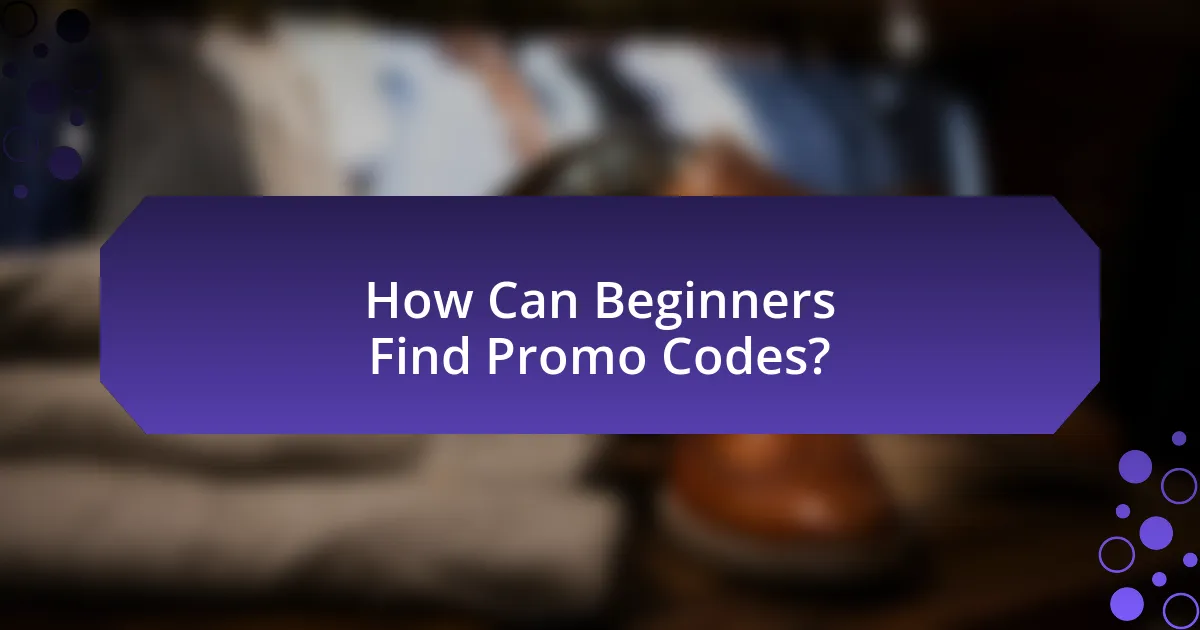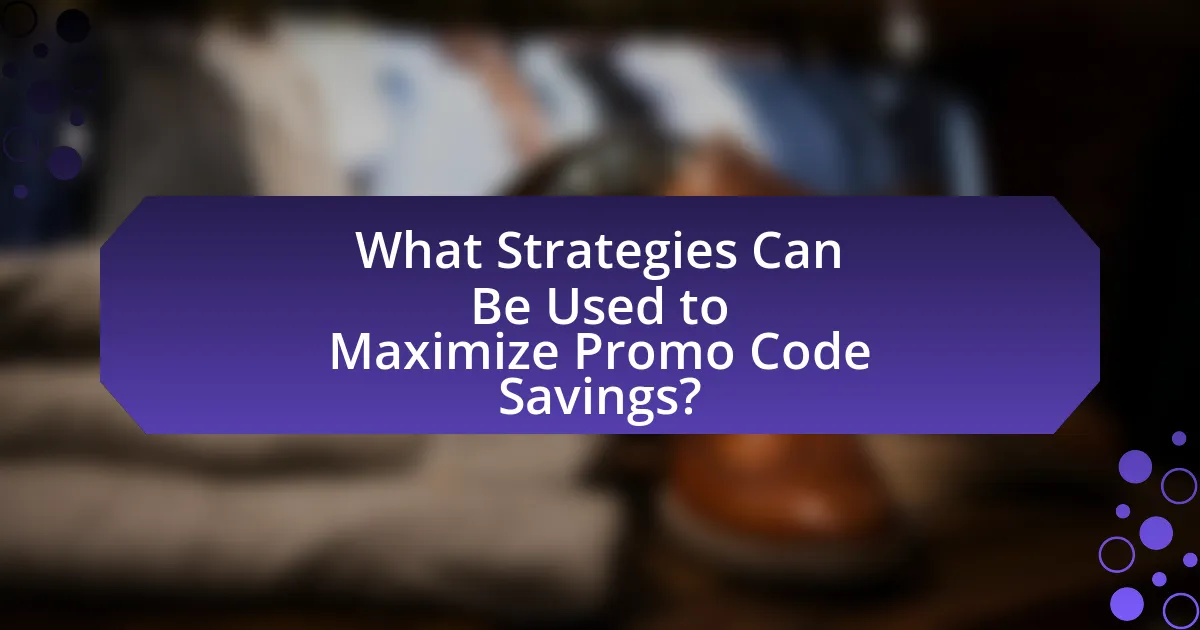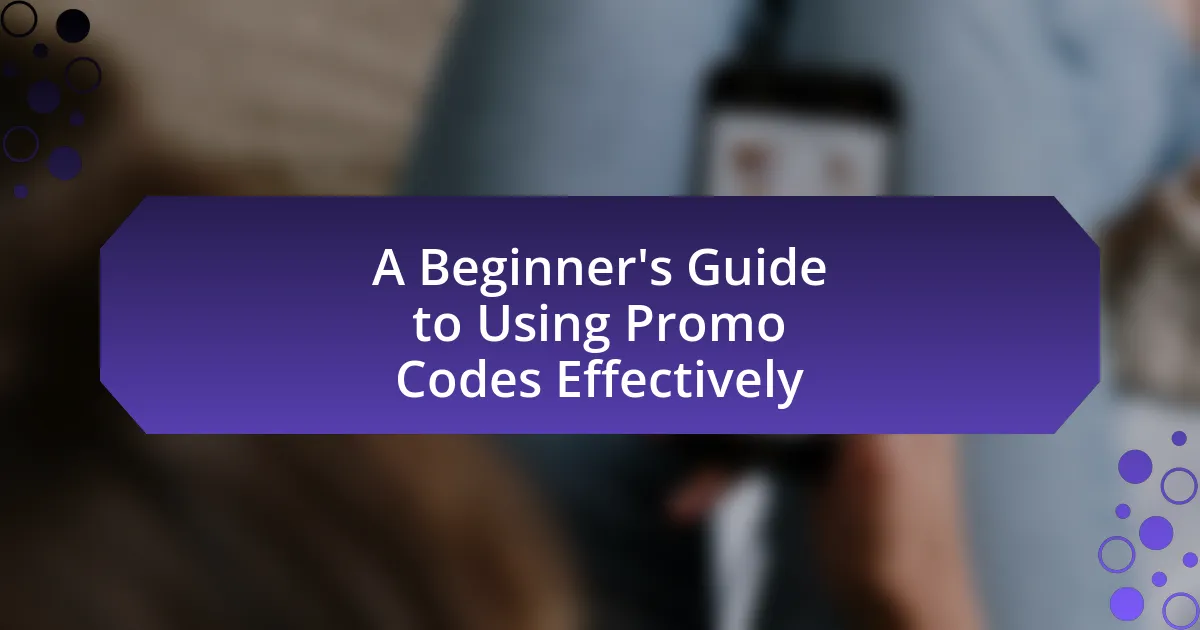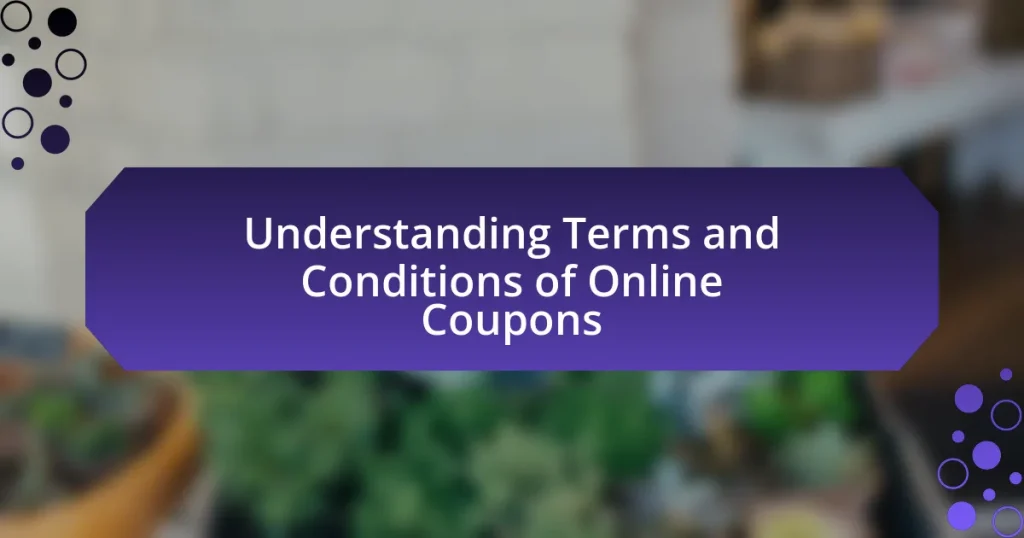Promo codes are alphanumeric strings that provide discounts or special offers during online purchases, significantly enhancing the shopping experience. This guide covers the various types of promo codes, including percentage-off, dollar-off, free shipping, and limited-time offers, while explaining how they work and their effectiveness in driving sales. It also offers practical advice for beginners on finding, verifying, and maximizing savings through promo codes, as well as common mistakes to avoid. Additionally, strategies for stacking codes and utilizing social media and newsletters to discover exclusive deals are discussed, ensuring consumers can make informed purchasing decisions and achieve substantial savings.

What are Promo Codes and How Do They Work?
Promo codes are alphanumeric strings that provide discounts or special offers when applied during a purchase. They work by allowing customers to enter the code at checkout, which then reduces the total price or grants additional benefits, such as free shipping. Promo codes are often distributed by retailers through various channels, including email newsletters, social media, and advertising campaigns, to incentivize purchases and attract new customers. According to a study by the National Retail Federation, 80% of consumers reported using a promo code at least once in the past year, highlighting their effectiveness in driving sales.
What types of promo codes are available?
There are several types of promo codes available, including percentage-off codes, dollar-off codes, free shipping codes, buy-one-get-one (BOGO) codes, and limited-time offer codes. Percentage-off codes provide a specific percentage discount on the total purchase, while dollar-off codes offer a fixed amount off the total price. Free shipping codes eliminate shipping fees, making online shopping more economical. BOGO codes allow customers to purchase one item and receive another for free or at a discount. Limited-time offer codes create urgency by providing discounts that expire after a certain period. Each type serves different promotional strategies to attract customers and increase sales.
How do percentage-off codes differ from dollar-off codes?
Percentage-off codes reduce the total price of a purchase by a specific percentage, while dollar-off codes provide a fixed monetary discount. For example, a 20% off code on a $100 purchase reduces the price by $20, resulting in a final cost of $80. In contrast, a $20 off code directly lowers the price to $80 without considering the original price percentage. This distinction is crucial for consumers to determine which type of code offers greater savings based on their purchase amount.
What are free shipping codes and how can they be used?
Free shipping codes are promotional codes that allow customers to receive shipping at no cost when making a purchase. These codes can be applied during the checkout process on e-commerce websites by entering the code in a designated field, which then deducts the shipping fees from the total order amount. Many retailers offer free shipping codes as part of marketing strategies to encourage sales, especially during promotional events or holidays.
Why should beginners use promo codes?
Beginners should use promo codes to save money on purchases and access exclusive deals. Utilizing promo codes can lead to significant discounts, often ranging from 10% to 50% off retail prices, which is particularly beneficial for those who are new to shopping online and may be unfamiliar with pricing strategies. According to a study by RetailMeNot, 80% of consumers reported using promo codes to save money, highlighting their effectiveness in reducing overall spending.
What savings can be achieved through promo codes?
Promo codes can achieve savings ranging from 5% to 50% off the total purchase price. Many retailers offer these codes to incentivize purchases, and studies show that consumers who use promo codes can save an average of 20% on their transactions. For instance, a survey by RetailMeNot indicated that 80% of consumers reported using promo codes to save money on their purchases, highlighting their effectiveness in reducing costs.
How do promo codes enhance the shopping experience?
Promo codes enhance the shopping experience by providing customers with discounts and incentives that make purchases more affordable. These codes can lead to significant savings, encouraging consumers to buy more items or try new products. Research indicates that 60% of online shoppers are motivated to complete a purchase when they have a promo code, demonstrating their effectiveness in driving sales and improving customer satisfaction. Additionally, promo codes create a sense of urgency and exclusivity, prompting shoppers to act quickly to take advantage of limited-time offers.

How Can Beginners Find Promo Codes?
Beginners can find promo codes by utilizing various online resources such as coupon websites, retailer newsletters, and social media platforms. Coupon websites like RetailMeNot and Coupons.com aggregate promo codes from numerous retailers, making it easy for users to search for discounts. Additionally, signing up for newsletters from favorite retailers often provides exclusive promo codes directly to subscribers. Social media platforms, particularly Facebook and Instagram, frequently feature promotional posts from brands that include time-sensitive codes. According to a 2022 survey by Statista, 80% of consumers reported using coupon codes to save money while shopping online, highlighting the effectiveness of these methods.
What are the best sources for discovering promo codes?
The best sources for discovering promo codes include dedicated coupon websites, retailer newsletters, and social media platforms. Coupon websites like RetailMeNot and Coupons.com aggregate various promo codes and often provide user-submitted codes that have been verified for accuracy. Retailer newsletters frequently offer exclusive discounts to subscribers, making them a reliable source for current promotions. Additionally, brands often share promo codes on their social media accounts, especially during sales events or holidays, which can lead to significant savings. These sources are widely recognized for their effectiveness in providing up-to-date and valid promo codes.
How do coupon websites aggregate promo codes?
Coupon websites aggregate promo codes by sourcing them from various retailers, user submissions, and partnerships with brands. These websites often utilize web scraping techniques to collect codes directly from retailer websites, ensuring they have the latest offers. Additionally, many coupon sites encourage users to submit codes they find, creating a community-driven aspect that helps keep the database updated. Partnerships with brands can also provide exclusive codes that are only available through specific coupon platforms. This multi-faceted approach allows coupon websites to maintain a comprehensive and current collection of promo codes for consumers.
What role do social media and newsletters play in finding promo codes?
Social media and newsletters are crucial tools for discovering promo codes, as they provide timely updates and exclusive offers directly from brands. Brands often share promo codes on their social media platforms, such as Facebook, Twitter, and Instagram, to engage with their audience and drive sales. For instance, a survey by Statista indicated that 54% of consumers follow brands on social media to stay informed about promotions. Similarly, newsletters serve as a direct communication channel where companies can send curated deals and promo codes to subscribers, ensuring that they receive the latest offers. According to a report by the Direct Marketing Association, email marketing, which includes newsletters, has an average return on investment of $42 for every dollar spent, highlighting its effectiveness in reaching consumers with promotional content.
How can beginners verify the validity of promo codes?
Beginners can verify the validity of promo codes by checking them on the retailer’s website or app before applying them at checkout. Many retailers display promo codes directly on their product pages or in promotional emails, ensuring that the codes are current and applicable. Additionally, beginners can use reputable coupon websites that aggregate and verify promo codes, providing user feedback on their effectiveness. This method is supported by the fact that many coupon sites, such as RetailMeNot and Coupons.com, regularly update their listings based on user submissions and retailer confirmations, enhancing the reliability of the codes provided.
What signs indicate a promo code may be expired or invalid?
Signs that indicate a promo code may be expired or invalid include receiving an error message when attempting to apply the code at checkout, the code not being accepted despite correct entry, and the absence of the code on the retailer’s website or promotional materials. Additionally, if the promo code has a specific expiration date that has passed, or if it is restricted to certain products or categories that do not apply to your purchase, these factors also suggest the code is no longer valid.
How can user reviews help in assessing promo code reliability?
User reviews can significantly aid in assessing promo code reliability by providing firsthand accounts of user experiences with specific codes. These reviews often detail whether the promo codes worked as advertised, the ease of application during checkout, and any issues encountered, such as expiration dates or restrictions. For instance, a study by BrightLocal in 2022 found that 79% of consumers trust online reviews as much as personal recommendations, indicating that user feedback can be a reliable indicator of a promo code’s effectiveness. Thus, analyzing user reviews allows potential users to gauge the likelihood of successfully using a promo code before attempting to apply it.

What Strategies Can Be Used to Maximize Promo Code Savings?
To maximize promo code savings, consumers should combine multiple strategies such as researching available codes, timing purchases during sales events, and stacking discounts. Researching involves checking websites and apps dedicated to aggregating promo codes, which can reveal additional savings opportunities. Timing purchases during major sales events, like Black Friday or Cyber Monday, often yields better discounts when combined with promo codes. Stacking discounts refers to using a promo code alongside other offers, such as free shipping or loyalty rewards, to enhance overall savings. These strategies are effective as they leverage various promotional opportunities to reduce costs significantly.
How can stacking promo codes increase savings?
Stacking promo codes can significantly increase savings by allowing consumers to apply multiple discounts to a single purchase. When shoppers use more than one promo code, they can combine percentage-off discounts, free shipping offers, and fixed-amount reductions, maximizing the total discount received. For example, if a customer has a 20% off coupon and a $10 off coupon, stacking these codes can lead to a greater overall reduction in price than using either code alone. This strategy is supported by various retail practices that permit multiple codes, enhancing the potential for savings during sales events or special promotions.
What are the limitations of stacking promo codes?
Stacking promo codes is often limited by retailer policies, which typically allow only one code per transaction. Many retailers explicitly state in their terms and conditions that combining multiple promo codes is prohibited, thereby restricting the potential savings a customer can achieve. Additionally, some promo codes may have specific exclusions or conditions that further limit their applicability when used together, such as minimum purchase requirements or restrictions on certain products. These limitations are designed to prevent excessive discounts and maintain profit margins for retailers.
How can beginners identify compatible promo codes for stacking?
Beginners can identify compatible promo codes for stacking by checking the terms and conditions of each code before applying them. Many retailers specify whether their promo codes can be combined with others, often indicating this information on their websites or promotional materials. Additionally, using coupon aggregation websites can help beginners find codes that are known to be stackable, as these platforms often provide user feedback and details on compatibility. For instance, sites like RetailMeNot or Honey frequently update their listings to reflect which codes work together, making it easier for users to maximize their savings.
What are some common mistakes to avoid when using promo codes?
Common mistakes to avoid when using promo codes include not checking expiration dates, overlooking terms and conditions, and failing to apply the code before completing the purchase. Expiration dates are crucial because many promo codes become invalid after a certain period, rendering them useless. Terms and conditions often specify restrictions, such as minimum purchase amounts or applicable products, which can lead to disappointment if not reviewed beforehand. Additionally, users frequently forget to enter the promo code at checkout, missing out on potential savings. According to a survey by RetailMeNot, 70% of consumers reported that they have forgotten to apply a promo code, highlighting the importance of careful attention during the checkout process.
How can beginners ensure they apply promo codes correctly at checkout?
Beginners can ensure they apply promo codes correctly at checkout by carefully entering the code in the designated field before finalizing the purchase. It is essential to double-check the spelling and format of the promo code, as even minor errors can lead to invalidation. Additionally, beginners should verify that the promo code is still active and applicable to the items in their cart, as many codes have expiration dates or specific restrictions. According to a study by RetailMeNot, 70% of consumers abandon their carts due to issues with promo codes, highlighting the importance of accuracy in this process.
What should beginners do if a promo code doesn’t work?
If a promo code doesn’t work, beginners should first check the code for any errors, such as typos or incorrect characters. Many promo codes have specific terms and conditions, including expiration dates and minimum purchase requirements, which can affect their validity. Beginners should also ensure that the promo code is applicable to the items in their cart, as some codes are restricted to certain products or categories. If the code still doesn’t work after these checks, contacting customer support for assistance is advisable, as they can provide clarification or resolve any issues related to the promo code.
What are some best practices for using promo codes effectively?
To use promo codes effectively, consumers should first verify the code’s validity and expiration date before attempting to apply it. This ensures that the promo code is still active and applicable to their purchase. Additionally, shoppers should compare multiple promo codes to find the best discount available, as different codes may offer varying benefits. Research indicates that using a combination of promo codes and sales can maximize savings, with studies showing that consumers can save an average of 20% when stacking discounts. Lastly, signing up for newsletters or loyalty programs often provides exclusive promo codes, enhancing the potential for savings.
How can setting alerts for promo codes benefit beginners?
Setting alerts for promo codes can significantly benefit beginners by ensuring they never miss out on discounts and savings opportunities. By receiving timely notifications, beginners can take advantage of limited-time offers and exclusive deals that may otherwise go unnoticed. This proactive approach not only enhances their shopping experience but also helps them save money effectively, as studies show that consumers who actively seek out and utilize promo codes can save an average of 10-20% on their purchases.
What tips can help beginners stay organized with promo codes?
To stay organized with promo codes, beginners should create a dedicated digital folder or spreadsheet to store all codes, categorizing them by retailer and expiration date. This method allows for easy access and management, ensuring that users can quickly find and apply the relevant codes before they expire. Research indicates that organized systems improve efficiency and reduce the likelihood of missing out on savings, as users can systematically track their promo codes and their validity.



